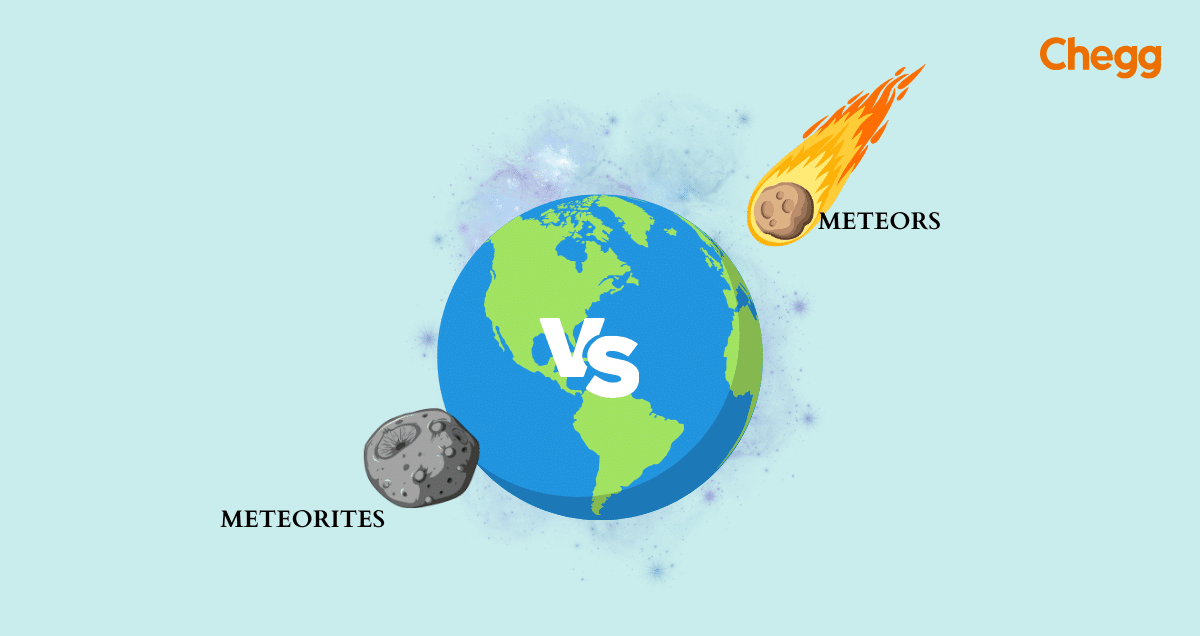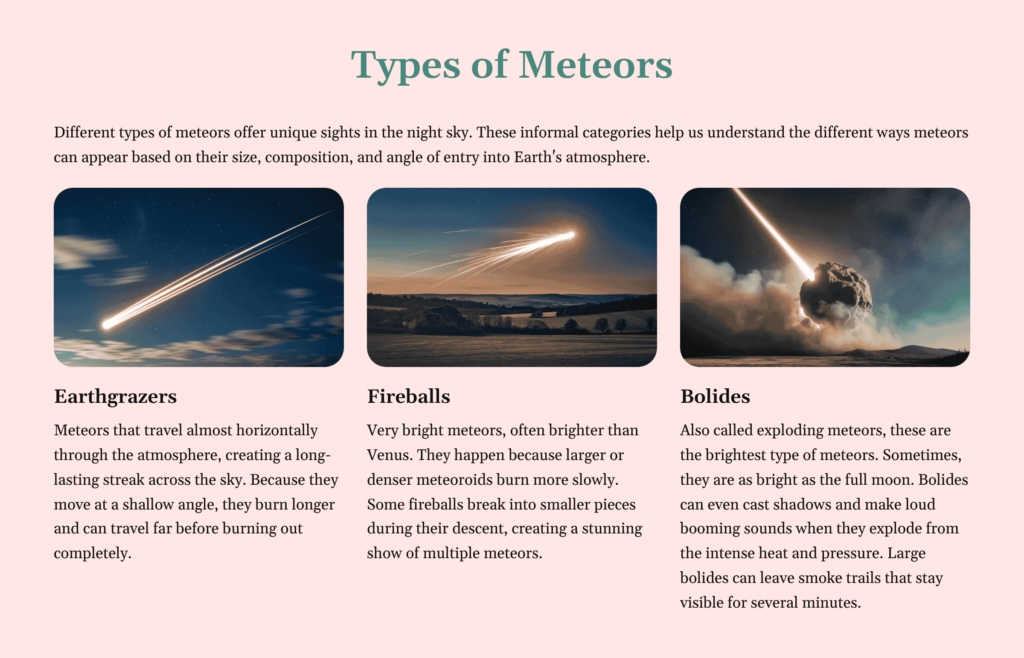
Quick Summary
Table of Contents
Ever looked up and spotted a shooting star? That flash of light is commonly called a meteor, but there’s much more to the story. This guide will break down the key difference between meteors and meteorites and explore how these space rocks affect Earth, science, and even culture by drawing a comparison among meteors vs meteorites.
Understanding the difference between meteors and meteorites is essential for anyone interested in astronomy or space science. While related, these celestial phenomena have distinct characteristics and play different roles in our solar system. This blog post will delve into the specifics of meteors vs meteorites, exploring their definitions, origins, characteristics, and significance. This comprehensive guide provides clear and concise information to help you distinguish between these two fascinating phenomena.
The answer to the question, “What is a meteor?” is simple. A meteor, commonly known as a “shooting star” or “falling star,” is a bright streak of light observed when a meteoroid enters the Earth’s atmosphere and vaporizes due to frictional heating. This event occurs high in the upper atmosphere, typically around 76 to 100 kilometers above the Earth. The light-producing phenomenon is known as a meteor, and it happens at incredible speeds, often exceeding 20 kilometers per second.
Meteors originate from meteoroids, which can be fragments of comets, asteroids, or other celestial bodies. When these meteoroids enter the Earth’s atmosphere, they encounter intense friction, causing them to heat up and produce a bright light trail.
Meteors, often called “shooting stars,” can be grouped based on how they look when observed. Here are some informal types of meteors:

Let us delve into the quesiton, “What is a meteorite?”, A meteorite is a fragment of a meteoroid or asteroid that survives its journey through the Earth’s atmosphere and lands on the surface. Meteorites can vary significantly in size, from tiny particles to large masses weighing several tons. They provide invaluable insights into the composition of other celestial bodies, particularly asteroids, and sometimes even planets or moons.
Meteorites are the remnants of meteoroids that do not completely burn up during their atmospheric entry. These fragments can come from asteroids, comets, or even the Moon and Mars.
Meteorites are fragments of meteoroids that survive their passage through the Earth’s atmosphere and land on the Earth’s surface. They are classified based on their composition and structure. Here are the main types of meteorites:

Meteorites provide valuable insights into the early solar system and the formation of planetary bodies. Stony meteorites, iron meteorites, and stony-iron meteorites each offer unique information about their origins and the processes that formed them. By studying meteorites, scientists can learn more about the history and composition of our solar system.
| Category | Meteors | Meteorites |
| Compositions | It is made up of meteoroids, comets, fragments, or asteroids. | Meteorites are survivors of the fiery atmospheric journey. |
| Density | Meteors exhibit varying densities, with their extraterrestrial origin contributing to unique density characteristics. | Meteorites are denser than typical Earth rocks due to their extraterrestrial origin. |
| Shape | Meteors are formed by burning meteoroids when they enter the atmosphere. | Meteorites maintain their original structure and composition. |
| Chemical Reactions | Intense heat causes chemical processes that contribute to meteor radiance. | Extreme temperatures upon entrance result in the production of fusion crust. |
| Types | It is composed of metals and silicate elements. | There are three types of meteorites: stony meteorites, iron meteorites, and stony-iron meteorites. |
| Definition | Intense heat causes chemical processes which contribute to meteor radiance. | Meteoroids are asteroid fragments that reach the Earth’s surface. |
| Identification | It is distinguished by examining direction, speed, brightness, and duration. | Identified by studying chemistry, structure, and traits such as fusion crust. |
| Occurrence | Meteors disintegrate before reaching the Earth’s surface, leaving trails of meteoric dust that contribute to the composition of the atmosphere. | Found in deserts, frigid locations, and areas with little human activity. |
| Impact | Meteorites are known as heavenly or supernatural artifacts and have historical importance in certain societies. They are being studied for their cultural significance and scientific usefulness. | Meteorites can strike the Earth’s surface and create impact craters. They provide important information on the makeup of celestial bodies and the early solar system. |
| Frequency Of Events | Meteor showers are prevalent, with regular displays. | Meteorite falls are relatively uncommon, with particular incidents caught on Earth. |
| Cultural Significance | Shooting stars are frequently connected with mythology, omens, and inspiration. Meteor showers are culturally significant in many civilizations. | Meteorites are known as heavenly or supernatural artifacts and have historical importance in certain societies. They are being studied for their cultural significance as well as their scientific usefulness. |
| Scientific Observation | The study of meteors contributes to our understanding of the solar system’s makeup. Meteor showers help scientists better comprehend celestial entities. | Meteorites are essential for scientific inquiry because they provide tangible samples of cosmic stuff. Meteorites aid in understanding the genesis and evolution of the solar system. |
| Potential Dangers | Meteors, because of their disintegration, pose no direct threat to Earth. | Meteors, because of their disintegration, pose no direct threat to Earth. |
| Human Activity | Meteors are observed for both recreational and scientific reasons. | Meteorites are in high demand for scientific and collector purposes. |
| Age | Radiometric dating techniques are used to determine the age of a meteor. | Meteorites can be dated using radiometric techniques. |
Difference between Meteors and meteorites play crucial roles in scientific exploration, offering valuable insights into our solar system and beyond. Here’s why they are scientifically significant:
Difference between meteors and meteorites are not just celestial curiosities but essential tools for understanding the origins, evolution, and potential hazards of our solar system.
Scientists estimate that about 48.5 tons (44,000 kilograms) of meteoritic material falls to Earth each day. Almost all of this material burns up in Earth’s atmosphere, creating bright trails called “shooting stars.”
On any given night, you can see several meteors per hour. Sometimes, the number of meteors increases a lot—these events are called meteor showers.

Meteor showers happen each year or at regular times when Earth passes through the trail of dust left by a comet. Meteor showers are named after a star or constellation near where the meteors appear in the sky. One of the most famous meteor showers is the Perseids, which peak every August. Each Perseid meteor is a tiny piece of the comet Swift-Tuttle, which comes close to the Sun every 135 years. Here are some well-known meteor showers:
Also Read :-
| 👉 Difference Between Speed and Velocity | 👉 Aneroid Barometer – How does it Operate? | 👉 Who Discovered Gravity | Isaac Newton |
Now you wonder about what is the difference between meteors and meteorites and meteoroids. Here is your answer:
| Feature | Meteoroid | Meteor | Meteorite |
|---|---|---|---|
| Location | Space | Earth’s atmosphere | Earth’s surface |
| Visibility | Not visible from Earth (unless entering atmosphere) | Streak of light in night sky (“shooting star”) | Physical object, can be found and touched |
| Fate | Orbits the sun, collides with another object, or enters a planet’s atmosphere | Burns up completely due to friction | Survives atmospheric entry and lands on Earth |
| Frequency | Very common | Relatively common, especially during showers | Rare, finding one is a stroke of luck |
| Scientific Value | Limited (composition clues) | Limited (understanding dust trails from comets) | High (physical sample for analysis) |
If you want to learn more, check out these helpful links:
By learning about the difference between meteors and meteorites, we can understand more about how our solar system works and the cool things happening in space. So keep looking up at the night sky—you might see an awesome meteor shower or even find a piece of space rock!
Meteors and meteorites are fascinating celestial phenomena that provide valuable insights into the universe. While meteors dazzle us with their brief but brilliant display in the night sky, meteorites offer tangible samples of space that help scientists unravel the mysteries of our solar system. Understanding the difference between meteors and meteorites enriches our knowledge of space and highlights the dynamic nature of our cosmic neighborhood.
By exploring these phenomena, we gain a greater appreciation for the intricate processes that shape our planet and the universe beyond. Whether you are an avid stargazer, a student of science, or simply curious about the wonders of space, delving into the world of meteors and meteorites is sure to inspire and enlighten.
A meteor is a streak of light produced when a meteoroid enters the Earth’s atmosphere and burns up due to friction. Commonly known as a “shooting star,” meteors are visible from the ground as bright trails across the sky.
A meteorite is a solid fragment of a meteoroid that survives its journey through the Earth’s atmosphere and lands on the Earth’s surface. Meteorites can be composed of rock, metal, or a combination of both.
Not all meteoroids turn into meteorites. When meteoroids enter Earth’s atmosphere, they create meteors, commonly known as shooting stars. While many meteors burn up in the atmosphere, some survive and land on Earth as meteorites.
In 1920, farmers discovered the Hoba meteorite, Earth’s largest intact meteorite weighing 60 tons, on a farm called Hoba West in northern Namibia. It fell less than 80,000 years ago and has remained untouched since discovery.
The Vredefort Crater in South Africa is the largest verified impact crater on Earth. It is estimated to be about 300 kilometers (186 miles) in diameter and is one of the oldest known impact structures, formed over 2 billion years ago.
The term “meteor” refers to the streak of light produced by a meteoroid entering Earth’s atmosphere and burning up due to friction. In contrast, a “meteorite” refers to the fragment of a meteoroid that survives the journey through the atmosphere and lands on Earth’s surface.

Authored by, Amay Mathur | Senior Editor




Amay Mathur is a business news reporter at Chegg.com. He previously worked for PCMag, Business Insider, The Messenger, and ZDNET as a reporter and copyeditor. His areas of coverage encompass tech, business, strategy, finance, and even space. He is a Columbia University graduate.
Editor's Recommendations
Chegg India does not ask for money to offer any opportunity with the company. We request you to be vigilant before sharing your personal and financial information with any third party. Beware of fraudulent activities claiming affiliation with our company and promising monetary rewards or benefits. Chegg India shall not be responsible for any losses resulting from such activities.
Chegg India does not ask for money to offer any opportunity with the company. We request you to be vigilant before sharing your personal and financial information with any third party. Beware of fraudulent activities claiming affiliation with our company and promising monetary rewards or benefits. Chegg India shall not be responsible for any losses resulting from such activities.